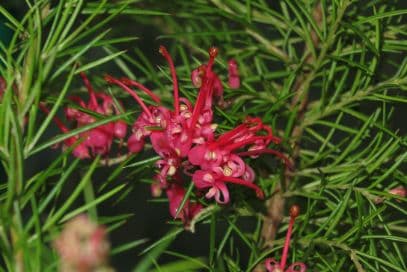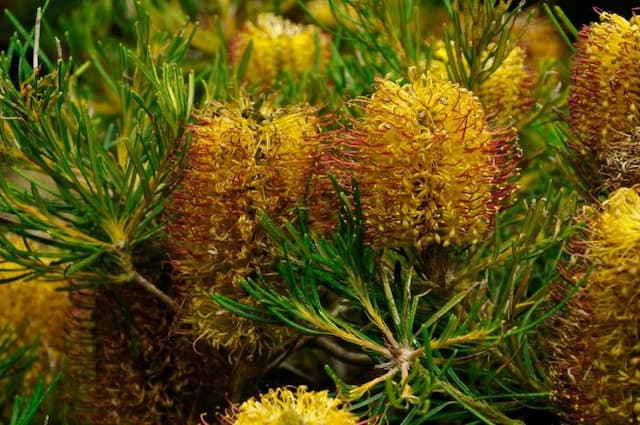Spider Flower Grevillea 'Olympic Flame'

ABOUT
Grevillea 'Olympic Flame' is a striking plant known for its vibrant and showy appearance. Its most distinctive feature is the profusion of fiery red and orange flowers that resemble the shape of a spider, bursting forth in great numbers, giving it a spectacular display that can remind one of the flames of a fire, hence its name. These vibrant blooms are known to attract a variety of birds, especially nectar-feeders, adding life and color to the garden. The foliage of this plant is equally attractive, with green leaves that are intricately divided and feathery in texture. The leaves tend to have a soft, silky feel and can sometimes have a silvery underside, contributing to the plant's overall lush appearance. This attractive, fine foliage provides a beautiful backdrop that contrasts with the bright flowers, making them stand out even more. Grevillea 'Olympic Flame' has a spreading habit, with branches that arch elegantly and can create a dense, bushy presence in the landscape. Throughout the seasons, as the plant matures and continues to bloom, it forms a spectacular and eye-catching specimen that can be a focal point in gardens, providing year-round interest with its evergreen leaves and seasonal floral display. Its resilience and ornamental qualities make it a popular choice for gardeners looking to add a touch of drama and natural beauty to their outdoor spaces.
About this plant
 Names
NamesFamily
Proteaceae
Synonyms
Olympic Flame Grevillea
Common names
Grevillea 'Olympic Flame'.
 Toxicity
ToxicityTo humans
Grevillea 'Olympic Flame', commonly known as Grevillea, can be toxic to humans if ingested. The plant contains compounds that can cause discomfort and irritation. Symptoms of poisoning may include nausea, vomiting, and diarrhoea. Additionally, contact with the skin can sometimes cause dermatitis, characterized by redness, itching, and blistering. It is advised to handle this plant with care and avoid ingestion to prevent any toxic effects.
To pets
Grevillea 'Olympic Flame', commonly referred to as Grevillea, is also potentially toxic to pets if ingested. The toxicity can cause similar symptoms in pets as it does in humans, including nausea, vomiting, and diarrhoea. Contact with the skin may lead to dermatitis, presenting as irritation, redness, or swelling. Owners should prevent their pets from ingesting or coming into contact with any part of the Grevillea plant to avoid these possible consequences.
 Characteristics
CharacteristicsLife cycle
Perennials
Foliage type
Evergreen
Color of leaves
Green
Flower color
Red
Height
6-10 feet (1.8-3.0 meters)
Spread
6-10 feet (1.8-3.0 meters)
Plant type
Shrub
Hardiness zones
9
Native area
Australia
Benefits
 General Benefits
General Benefits- Attractive Flowers: Grevillea 'Olympic Flame' produces vibrant red flowers that add a pop of color to any landscape.
- Drought Tolerance: This plant is well adapted to dry conditions, making it ideal for water-wise gardens.
- Easy Maintenance: Requires minimal care once established, with no need for frequent watering or fertilizing.
- Wildlife Attraction: The nectar-rich flowers attract birds, butterflies, and bees, promoting biodiversity.
- Fast Growing: It can grow quickly to form a screen or hedge, providing privacy and wind protection.
- Year-Round Interest: With its evergreen foliage and long flowering period, it offers visual appeal throughout the year.
- Soil Adaptability: Tolerates a range of soil types, although it prefers well-drained conditions.
- Low Fertilizer Need: It typically does not require high levels of fertilization, making maintenance easier.
 Medical Properties
Medical PropertiesThis plant is not used for medical purposes.
 Air-purifying Qualities
Air-purifying QualitiesThis plant is not specifically known for air purifying qualities.
 Other Uses
Other Uses- The foliage of Grevillea can be used in floral arrangements to add texture and a touch of the exotic, with its unique foliage and vibrant, spidery flowers.
- Grevillea flowers can attract beneficial insects to the garden, which can help pollinate plants and manage pest populations.
- The nectar-rich blossoms can be a food source for birds, particularly nectar-feeding birds such as honeyeaters and lorikeets, promoting avian biodiversity in the garden.
- The dense shrub can serve as a natural privacy screen or hedge when planted in rows or groups, providing a barrier against wind or noise.
- Grevillea can be pruned into interesting shapes and is suitable for topiary, giving gardeners a chance to be creative with plant sculpting.
- The plant can be used in erosion control on slopes or banks, due to its deep root systems that help stabilize soil.
- Grevillea wood, though not commonly used due to its limited size, may be suitable for small woodworking projects such as inlays or crafting small objects.
- The large shrub can provide a protective habitat for ground-dwelling wildlife like lizards and insects, contributing to local ecological balance.
- During winter, when flowers might be scarce, Grevillea can add color to an otherwise dull garden landscape.
- If allowed to grow without much pruning, Grevillea can develop into an informal play area for children, who can enjoy the dense branches and foliage as a natural hideaway.
Interesting Facts
 Feng Shui
Feng ShuiThe Grevillea is not used in Feng Shui practice.
 Zodiac Sign Compitability
Zodiac Sign CompitabilityThe Grevillea is not used in astrology practice.
 Plant Symbolism
Plant Symbolism- Resilience: Grevillea 'Olympic Flame' has a hardy nature, reflecting the ability to withstand challenging conditions and symbolizing the strength to endure and thrive.
- Unique Beauty: With its distinctive and vibrant blooms, it represents the celebration of uniqueness and individual beauty.
- Athletic Excellence: The name 'Olympic Flame' ties it to the spirit of the Olympics, symbolizing achievement, competition, and the pursuit of excellence.
- Passion: The fiery colors of the flowers can represent intense feelings, enthusiasm, and passionate love.
- Adaptability: As the plant can adapt to various soil types and environments, it signifies flexibility and the ability to prosper in different circumstances.
 Water
WaterThe Spider Flower should be watered regularly, aiming for once a week during active growth and less during winter, ensuring the soil is well-drained and never waterlogged. Deep watering is preferred to encourage strong root development—use about 1 gallon per watering for an established plant, adjusting based on rainfall and temperature.
 Light
LightSpider Flowers flourish in full sunlight but can tolerate partial shade. The best spot for this plant is in an area where it can receive at least 6 hours of direct sunlight daily, which encourages optimal growth and blooming.
 Temperature
TemperatureSpider Flowers are hardy in warmer climates, with the ideal temperature range between 60°F and 75°F. They can survive minimum temperatures down to about 20°F but may suffer frost damage; temperatures above 90°F might stress the plant if not well-watered.
 Pruning
PruningPrune the Spider Flower to maintain shape and encourage bushier growth, typically after the blooming cycle in late winter or early spring. Cut back by about one-third, removing any dead or spindly branches, to promote healthy new growth.
 Cleaning
CleaningAs needed
 Soil
SoilThe Grevillea 'Olympic Flame' prefers a well-draining soil mix composed of equal parts loam, sand, and compost to ensure good aeration and drainage. A slightly acidic to neutral pH of 5.5 to 7.0 is ideal for this shrub.
 Repotting
RepottingThe Spider Flower (Grevillea 'Olympic Flame') generally should be repotted every 2 to 3 years or when it outgrows its current container to ensure continued growth and health.
 Humidity & Misting
Humidity & MistingGrevillea 'Olympic Flame' prefers moderate humidity levels, but being a drought-tolerant plant, it can withstand lower humidity without significant impact.
 Suitable locations
Suitable locationsIndoor
Ensure bright light, well-draining soil, and minimal watering.
Outdoor
Full sun, well-drained soil, protect from frost.
Hardiness zone
9-11 USDA
 Life cycle
Life cycleGrevillea 'Olympic Flame', also known as Spider Flower, begins its cycle when seeds are sown or cuttings are taken to start new plants. The seeds germinate, or the cuttings root, eventually developing into juvenile plants with characteristic needle-like leaves. As the Spider Flower matures, it enters a vigorous growth phase, producing robust woody stems and evergreen foliage, and becoming increasingly drought and frost tolerant. The adult plant reaches flowering maturity, where bright red, spider-like flowers blossom, primarily in winter and spring, attracting birds and insects for pollination. Following pollination, the plant develops fruit which are follicles that release seeds when mature, ready to start a new generation. Throughout its life, the Grevillea 'Olympic Flame' may undergo pruning to maintain shape and promote denser growth and flowering.
 Propogation
PropogationPropogation time
Spring-Early Summer
Propogation: The Grevillea 'Olympic Flame' is often propagated through semi-hardwood cuttings, a method most effective during the late summer to early fall when plant material has partially matured but is not fully hardened. To undertake this propagation, a grower should select healthy, semi-ripe stems and cut a section approximately 4 to 6 inches (10 to 15 centimeters) in length, just below a leaf node. Leaves on the lower half of the cutting should be removed, and the cut end may be dipped in rooting hormone to facilitate root development. The cutting should then be placed in a well-draining propagation mix, ensuring good contact between the mix and the cut end. Maintaining a humid environment by covering the cuttings with a plastic dome or bag and placing them in indirect sunlight can improve the chances of successful rooting, which should occur in several weeks. Once roots are established, the new plant can be gradually acclimatized to less humid conditions before transplanting into its permanent location.




